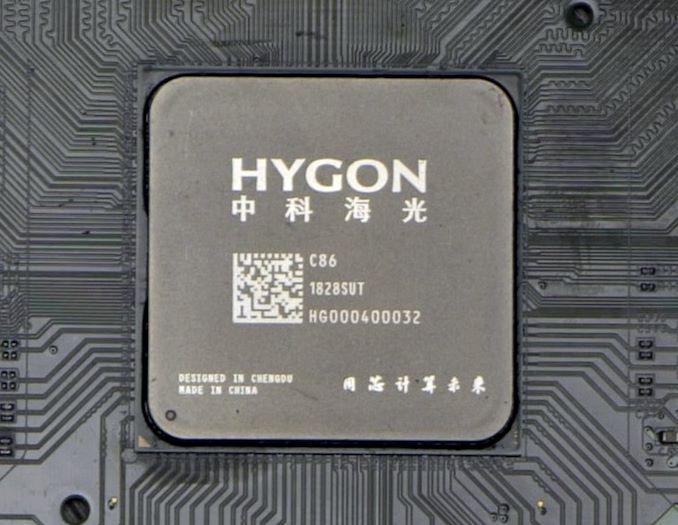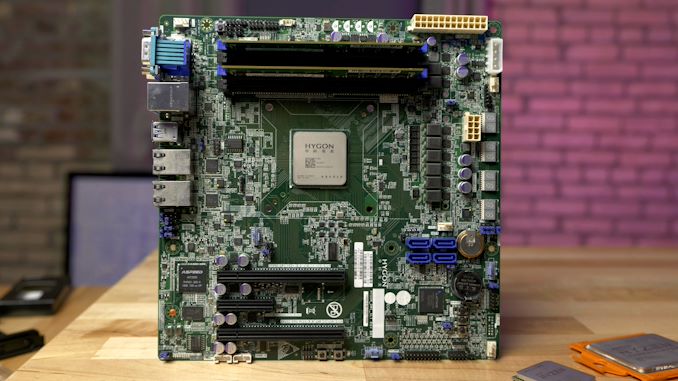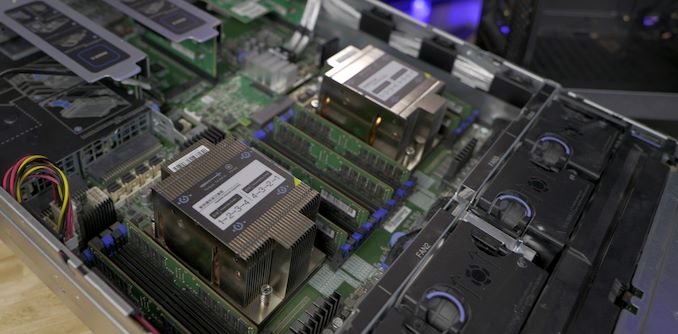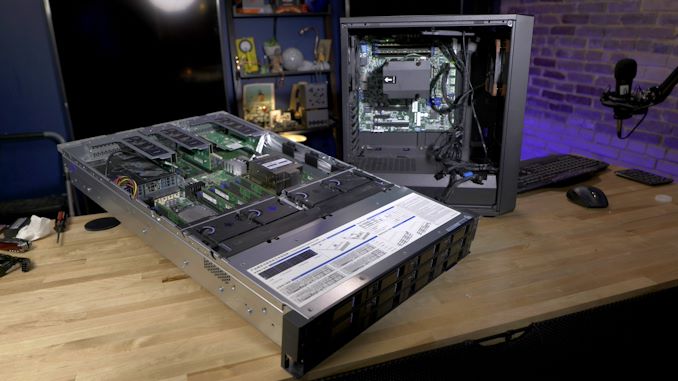Testing a Chinese x86 CPU: A Deep Dive into Zen-based Hygon Dhyana Processors
by Dr. Ian Cutress & Wendell Wilson on February 27, 2020 9:00 AM ESTOur Hygon Systems
8-core Dhyana and Dual 32-core Dhyana Plus
The full range of Hygon’s known releases boils down to two platforms: one containing a single 8-core Zen 1 die, similar to the desktop range of processors (or EPYC 3000), and a set of server processors built from four dies in a similar arrangement to Naples.
The 8-core engineering sample system we have in to test didn’t provide any exact SKU numbering – on the CPU it says ‘C86’ which is meant to imply ‘Chinese x86’. The rest of the numbering is likely linked to the wafer and batch that this silicon came from, however we do not have decoder rings for those.
The motherboard uses a microATX form factor, and is very much a server motherboard with the DDR4 slots horizontal rather than vertical in order to direct airflow through the system in a server chassis. Starting primarily with the socket, what we have is a non-socketed BGA design, such that this CPU cannot be upgraded because it is bonded to the motherboard, similar to what we see with laptops and embedded systems. The mounting holes are the thing that surprises me here – these are not the AM4 mounting holes that we typically see with the consumer version of Ryzen, but these mounting holes are Intel mounting holes. Someone must have a lot of old Intel coolers around, I guess? Either that or it makes it easier for Hygon’s partners to find specific server grade coolers.
The CPU has a six-phase power delivery system, and as this is a pure CPU product, there is no integrated graphics. There is a form of 2D graphics provided by the IPMI controller in the bottom left, the classic ASPEED AST2500 chip that we commonly see in server systems. Unlike other microATX motherboards, there isn’t the typical four slot design here, but a three slot design, with two full length PCIe 3.0 slots (capable of x16/x0 or x8/x8) and an open ended PCIe x4 slot.
Normally these CPUs don’t really need a chipset because they have some SoC level IO functionality on the silicon, though consumer Ryzen CPUs were paired with X370 chipsets when the Ryzen 1000 family first launched. Instead of using those chipsets, Hygon has paired the CPU with a Lattice Semiconductor FPGA to act as a chipset of sorts. This gives the motherboard an odd set of combined IO, including SATA ports, four dual LED displays, a number of custom connectors and buttons, and a lot of undocumented things we don’t know. For example, there appears to be two batteries on the motherboard – one presumably to keep the onboard time, but the other seems more permanent and is not obvious why it is there.
Here’s the motherboard where we’ve put an equivalent AM4 consumer Ryzen CPU on top, to show the size.
By comparison, the dual socket server is a bit of a beast. As we understand it, these servers were built for both compute and storage, with each CPU paired with four breakout connectors capable of four U.2 drives or 16-way SATA connectivity. The CPUs have eight channel memory capabilities, but due to a couple of reasons we had to test them in quad channel mode.
The CPUs in this case also say C86, but also have the model number 7185 on them, indicating a 32-core CPU. The carry case is red, whereas Naples EPYC CPUs were blue, Threadripper CPUs are orange, and Rome EPYC CPUs are green. The red might be a nod to the Chinese angle for these CPUs, however no-one we spoke to was able to confirm this.
The server is actually a Sugon design, with 12 front panel 2.5-inch drive slots. For the 8-core system, that was put into a standard desktop case and fitted with a CPU cooler. Both systems were tested though remote desktop access, as Wendell was hosting them in his labs in Kentucky while I’m all the way back in London.
When trying to probe the CPUs, CPU-Z didn’t seem to have much of a clue. The software provided this interface on the 8-core consumer, showing a 3.2 GHz frequency, but only one core, and no other details aside from support for AVX, AVX2, and FMA3. For the server CPUs, CPU-Z failed to run at all. What we were able to determine is that the software thought that every core was a separate socket, and it appears that some of the usual ways to access this data on the AMD consumer CPUs have all been changed here for the Hygon models, either to evade detection using usual methods, or to conform to different standards. One interesting note is that while CPU-Z detected AVX and AVX2, some of our software couldn’t, and we had to revert to SSE detection in order to get that software to even run.

















133 Comments
View All Comments
anarekist - Thursday, February 27, 2020 - link
that was a great and detailed article, very much appreciated.Notmyusualid - Sunday, March 1, 2020 - link
I very much enjoyed it also.PeterCordes - Thursday, February 27, 2020 - link
RDRAND isn't just a PRNG, it's still supposed to be based on true randomness. https://en.wikipedia.org/wiki/RDRANDIt being faster doesn't necessarily indicate lower quality. See https://crypto.stackexchange.com/questions/29894/a... for some hardware details on the circuit AMD uses to turn analogue noise into digital randomness. (Apparently sampling asynchronous ring oscillators, and feeding that through some digital mixing functions (e.g. a hash) to "whiten" the result. Intel's design is similar, but based on sampling thermal noise.)
RDSEED is merely even higher-quality randomness, suitable for seeding a PRNG instead of using directly. (It does not, as you mis-state, seed RDRAND. It's just a differently-processed way of pulling data from the same true HW randomness). Also unlike Linux /dev/random, it doesn't collect randomness from "various sources" into an entropy pool; my understanding is that all the randomness comes from a true HW RNG.
Perhaps they had to redesign (for export-control reasons) the digital mixing functions that "whiten" the hardware randomness? A much more conservative approach for RDSEED could easily explain it being much slower, like if they didn't want to trust AMD's design not to have NSA back-doors. Or simply a lower-effort or less skilled redesign by a 3rd party that wasn't part of the original design could account for it.
AMD Zen had some RDRAND bugs (like always returning -1 in some conditions) that were fixed by microcode updates; perhaps Hygon fixed that in hardware instead of microcode if there was any problem that AMD used to need to work around?
Duto - Thursday, February 27, 2020 - link
Good job in calming the concerns of many, and we appreciate it. However, nothing can change the fact that valuable American technology was transferred to a foreign and potentially hostile power, who is led by a dictatorship that violates #humanrights on a daily basis, yes continental China. Equally problematic is the fact that for a few dollars, AMD shoots on its feet, no turning back on that. It is evident that such disgrace took place under a very weak administration at home, in the current administration watch that wouldn’t happen, ever. So glad they close the deal for good!sarafino - Thursday, February 27, 2020 - link
"Equally problematic is the fact that for a few dollars, AMD shoots on its feet, no turning back on that."How exactly did they do that? They shared designs based on their older (outdated), slower Zen core. As you can plainly see in this review, Hygon's processors are not exact setting the world on fire in terms of performance. They're slower than 3 year old Zen 1 processors and significantly slower than any Zen 2, or soon, Zen 3 processors. You're making a mountain out of a mole hill.
Oxford Guy - Friday, February 28, 2020 - link
Perhaps, but also consider that some of the world's leading supercomputers were made with Piledriver CPUs.Journalists like Hruska never miss an opportunity to mock AMD for its "construction core" debacle but when they talk about the poor performance of the parts they never mention how many supercomputers used them successfully. Sometimes being cheap and adequate is enough, especially when paired with high-performance GPUs.
29a - Monday, March 2, 2020 - link
There is one in the Top 500 and it's ranked 481.Retycint - Thursday, February 27, 2020 - link
I wouldn't be so sure that the "transfer of American tech to a foreign hostile power" won't happen under the current administration, given that they seem to have a special affinity for the Russianss.yu - Sunday, March 1, 2020 - link
>they seem to have a special affinity for the RussiansNot "they", but "he".
What exactly has he transferred to Russia that hasn't been stopped by congress?
jospoortvliet - Monday, March 2, 2020 - link
Pretty much Syria, for one... and if he wasn't dragging his feed on support for Ukraine perhaps it would be free of russian soldiers by now as well.I know, it isnt intellectual property hehe